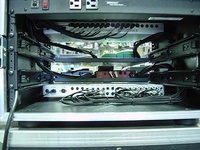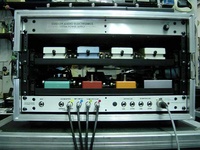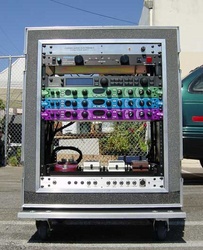
Home | FAQ | CAE News | Contact Us

The Custom Shop
An Introduction to Custom Switching Systems
Introduction
Congratulations! This is what you have been searching for... an uncompromised system designed for your unique and specific needs. No more must you rely on "off the shelf", mass-produced, so-called "pro" switching systems. Which, more often than not, are inferior copies of my original designs. No more must you patch together multiple little switching boxes to make a complete system. CAE custom switchers give you EXACTLY what you need with uncompromised quality and bulletproof reliability. Each custom switcher is hand built by me after consulting directly with you. There are no surprises... except when you plug in and realize just how good you can sound! I have been designing and building custom systems for over 20 years for some of the best players in the business. Take advantage of my experience and expertise... you won't be disappointed. Custom switchers are the heart and soul of CAE. We are the original "Custom Shop". After all, its in our name! Read on and see just how easy it is to design your system and get exactly what you need. Be sure to check out our FAQ page for additional information about Custom Switching Systems.
Description
CAE custom switchers generally come in a single rack space chassis. All functions are MIDI controlled using control number commands. Usually, sends and returns (to and from effects) are on the rear panel, as well as other patch points that complete the signal path to other units within the rack. The front panel has connectors to what we refer to as the "outside world" i.e. connections to and from the pedalboard/controller, as well as connections to amplifiers/power amps and any other external devices. These are heavy duty connectors able to withstand years of daily use.


Features
 Custom built. Exactly the functions you need with the legendary quality and reliability you've come to expect from CAE.
Custom built. Exactly the functions you need with the legendary quality and reliability you've come to expect from CAE.- Super high quality audio circuits with passive relay based switching.
- Compact single rack space construction keeps system size and weight to a minimum.
- Many MIDI controlled functions in a single rack space (up to 24 depending on type). More than any other switcher on the market!
- Many extras included in the price. In addition to the MIDI controlled functions, you get at no extra charge:
- Signal Buffers at strategic locations in the signal path.
- Tuner output
- Patch points (jacks) for external devices such as wah/volume pedals.
- Isolated "Pass thru's" on the front panel for patching devices from the "outside world" to rear panel connections on effects. This could include tap tempo switches, modulation pedals, etc.
- Rugged XLR connector for the CAE RS-10 Midi Foot Controller. Cable included!
- Other options may be added at no charge depending on system requirements.
Benefits
 Ultimate in sonic transparency. No matter how big your system is, it will still sound like you plugged straight into your amp. Switching elements are passive relays. There is very little active circuitry in the signal path, only enough to insure sonic integrity.
Ultimate in sonic transparency. No matter how big your system is, it will still sound like you plugged straight into your amp. Switching elements are passive relays. There is very little active circuitry in the signal path, only enough to insure sonic integrity.Easy to trouble shoot. Unlike a traditional pedal board, custom switchers are based on easily isolated blocks, or sections. Not only do switching loops 100% bypass the effects, but also the cables connecting the effects! Not so with a pedal board.
Minimal external connections to complete your basic signal path. The fewer the connections, the less chance you have of having an interconnection problem. Large portions of the signal path of CAE custom switchers are hard-wired, and NO connectors are printed circuit board mounted. This greatly increases reliability. On some available switchers, just to complete a simple 8 loop series signal path, 7(!) cables must be used between the input and output of the chain! And this doesn't include the cables needed to and from the effects! All loop sends and returns are half-normalled, further reducing connection/signal path problems.
Circuits can be optimized to work with your specific gear. Guitar equipment comes in all shapes, sizes and specs. There is no standardization and no guarantee it will all work properly when connected TOGETHER. With over 20 years experience in building guitar systems,and nothing BUT guitar systems, we know what works well together, and if not, we'll figure it out! Impedance, operating levels, and other factors come into play when asking multiple devices to work together in a system. If something needs a special tweak, we can do it.
Types of Functions Available
Discrete in-line bypass loop
Discrete inline bypass loops consist of separate Input, output, send and return jacks. The loop is in bypass (input passes to output) with a midi controller value of between 0 and 64. With a midi controller value from 65 to 127, Loop is engaged (input passes to send, then to effect input; effect output passes from return to loop output). Both the effect's input and output are electronically disconnected from the loop signal path when in bypass mode. This is known as 100% bypassing.In-line bypass loop (as part of a series chain)
When in-line loops are used as part of a series chain, they work exactly as described above, the only difference is each loop input and output is internally hard-wired in the signal path. This greatly reduces the number of jacks needed to complete a signal path at the expense of reduced inter-loop patching capability. The benefit is more loops are possible due to reduced jack count ( the in/out jacks can be used for more sends/returns). This is especially useful if you know what your signal path is going to be. In other words, if you know you will have 6 pedals in series, you only need 1 input jack, 1 output jack and 6 sets of sends/returns. Loop 1 feeds loop 2, loop 2 feeds loop 3, etc... These fixed configurations are how we are able to get so many functions in a single rack space, since redundant jacks are eliminated.(This also increases reliability). Also, since the series chains are half-normalled, you can use them as a switchable signal splitter!Audio Mute
Audio mutes consist of an input jack and an output (or send) jack. The signal is muted (no input passes to output) with a midi controller value of between 0 and 64. With a midi controller value from 65 to 127, Mute is engaged (input passes to output (or send) jack. This function is used when you just need to stop a signal, and is primarily used to bypass effects when using a line mixer. This is especially useful when muting the input of time based effects (delay& reverb) to create a natural decay (spillover) when bypassing.Switched Output
Switched outputs are essentially the same as audio mutes and are controlled via midi the same way. The difference is they usually come at the end of a pedal chain. Their outputs (sends) are most often transformer isolated, and feed the inputs of amplifiers.Control Functions
Control functions are chassis ground isolated relay contact closures mainly used for channel switching amps. They are also used where any "foot switch" type circuit is necessary, such as remote bypass on some effects processors, as well as speed (or rate) controls, etc... These functions are typically wired to 1/4" jacks, but can be wired to any type of connector. They are available as:- Normally open
With a midi controller value of between 0 and 64, contacts are open.
With a midi controller value of between 65 and 127, contacts are closed. - Normally closed
With a midi controller value of between 0 and 64, contacts are closed.
With a midi controller value of between 65 and 127, contacts are open. - Momentary
- With a midi controller value of between 0 and 64, contacts are open.
- With a midi controller value of between 65 and 127 contacts are momentarily closed for 60 milliseconds.
- Normally closed can be configured as well. In this case, contacts open momentarily for 60 milliseconds.
Please note, momentary functions are tricky and are not recommended. This is due to the open ended function of a momentary contact, (no feedback from the device you are trying to control) and its relationship to the LED indicator on the foot controller. You have to sync up the function on the device you are trying to control to the LED on the foot controller so that when the led is lit on the foot controller, the device is "active". This can sometimes be difficult to achieve, especially when the function is part of the footcontroller's "presets".
Additional Circuits Available
 In addition to the functions mentioned above, other specialized circuits are available, at additional cost.
In addition to the functions mentioned above, other specialized circuits are available, at additional cost.
Transformer Isolated Inputs/Outputs
An example here would be a transformer isolated wireless receiver input. This would eliminate possible ground loop hum caused by connection of a rack-mounted AC grounded wireless unit. The higher transformer secondary impedance will also help sensitive discrete transistor effects (typically fuzz boxes) think they are directly connected to a high impedance guitar pickup. Transformer isolated outputs do the same thing: that is, they electronically isolate the ground (common), thus eliminating ground loop hum.Selectable Inputs
We have already discussed switchable outputs, but switchable inputs are a possibility as well. Say you had two different instruments that you wanted plugged in and ready at all times. You could have them set up and ready, hit a foot switch, and be ready to go. We recently did a system where the player played both guitar and bass through the same system. The bass stayed plugged in and ready. All he had to do is put down the guitar, pick up the bass, and hit the "bass" footswitch. This footswitch selected both the bass input as well as the output to the bass amp!Mixing (summing) Circuits
Mixing audio signals can be extremely useful in a guitar system. See our Line Mixer page for details on how they can help you. Custom switchers can include anything from simple 2-input summing circuits (for combining outputs of wireless receivers, for example) to more elaborate multi channel stereo effects mixing.Splitting Circuits
Splitting audio signals is often required when you need a signal to get to more than one place simultaneously. One example is when you need to use multiple amps together at the same time. Another is when you need to feed multiple effects at the same time while mixing their outputs together. All of this is easily accomplished in a CAE custom switcher.Balanced (D.I.) Outputs
Sometimes a balanced output is required to feed the P.A. or for recording purposes. No problem here. We usually use high quality Jensen transformers for this. Outputs can be made footswitch selectable as well.Level Shifting Circuits
Often it is necessary to boost or cut signal level to and from various devices. For example, you may want to use instrument level pedals in the line level effects loop of your amp (or between your Preamp and power amp). Or perhaps you want to use a piece of line level (rack) gear between your guitar and amp. We can provide the necessary circuits to make this happen.???
Need something not described here? Let us know. We can probably make it work.



